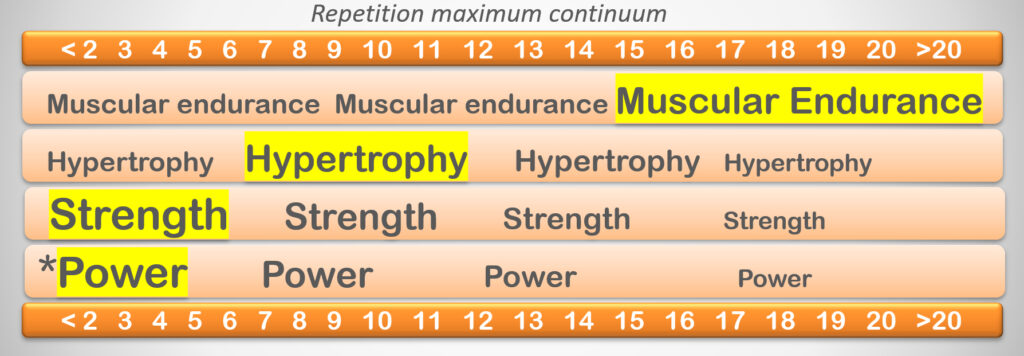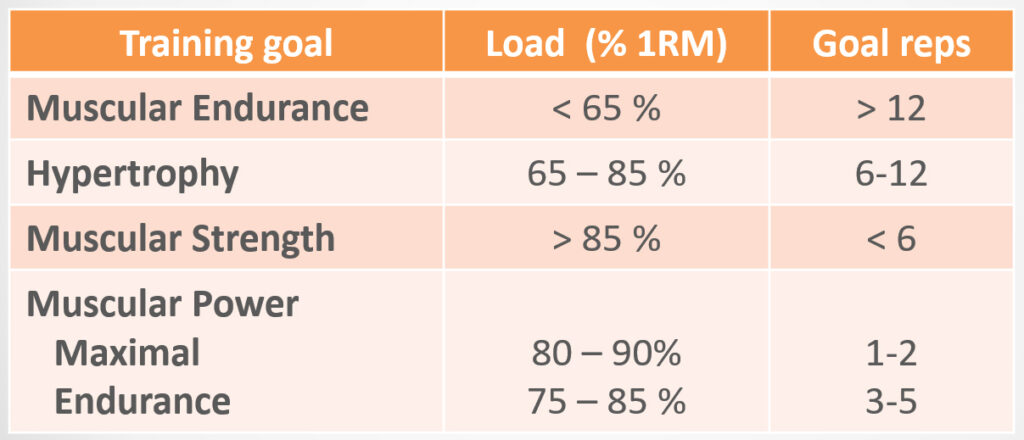The relationship between training load (how much weight you push) and repetitions (how many times you push it) is one of the most important resistance training variables you’ll manipulate – this article will teach you how to do it correctly. Let’s start by reviewing the figure below.
 *Power training often features loads ranging from 75 % to 85 % of 1RM, 3-5 reps. Adapted from Haff, G.G, & Triplett, N.T., Essentials of Strength Training and Conditioning. 4th ed. 2016, Champaign, IL: Human Kinetics
*Power training often features loads ranging from 75 % to 85 % of 1RM, 3-5 reps. Adapted from Haff, G.G, & Triplett, N.T., Essentials of Strength Training and Conditioning. 4th ed. 2016, Champaign, IL: Human KineticsThe first thing to notice in this figure is that the horizontal axis displays repetitions from < 2 to > 20. This is generally referred to as the repetition maximum continuum, which relies on the assumption that you’re performing repetitions until failure i.e. there is nothing left in the gas tank at the end of your set. The size of the font in this figure tells us what repetition range is associated with what muscular parameter. For example, if you want to train for muscle endurance, you should be hitting repetitions in the 15 to 20 range. Likewise, if your goal is muscular hypertrophy then you should be reaching failure in the 7 to 12 range. If you’re goal is to develop maximal strength, then you should be training with weight that you can only push 1 to 5 times.
It may seem strange to see that the rep range for power is the same for strength; but we must make a very important distinction here. To optimize power generation, all power exercises should be performed at 0 % (body weight only) to 85 % of your 1 repetition maximum. Normally you’re in the 75 % to 85 % range for most Olympic lifts. Importantly, you’re not training to failure when you train power. Rather, you’re training your body to contract your muscles faster. It’s not about how much weight you can move -that is what strength-focused reps are for. There is a very large neural component to power training, and this is what a lot of people don’t get.
Read: Essential resistance training exercises for MMA fighters
So, let’s give you a power-based example: Let’s say after some performance testing it’s determined you can complete 10 reps of power clean using 105 lbs and your 1 RM is estimated to be 140 lbs. There are tables that allow you to back-calculate your 1RM from a 10 RM – these tables are useful because most people shouldn’t be doing 100 % 1RM’s with Olympic lifts. In any case, if you back-calculate your 1RM for the power clean to be 140 and you’re working at the 75 % range, you should use 105 lbs for your load, but only complete 3 to 5 reps. You could do more, but you should rarely train power to failure.
Read: How to order resistance exercises in a workout
The percentage of your 1RM that you work at is called your load assignment, and as it turns out there are specific load assignments for each muscular parameter we talked about. These are displayed in the figure below.
 Adapted from Haff, G.G, & Triplett, N.T., Essentials of Strength Training and Conditioning. 4th ed. 2016, Champaign, IL: Human Kinetics
Adapted from Haff, G.G, & Triplett, N.T., Essentials of Strength Training and Conditioning. 4th ed. 2016, Champaign, IL: Human KineticsIf you want to know more about testing your 1RM, check out our article series on performance testing.
The above figure is rather intuitive, it simply says that you can perform more repetitions with lighter loads, and fewer with heavier loads. For muscle endurance, most people can work at about 65 % of their 1RM, which gets them somewhere between 12 to 20 repetitions. For muscle hypertrophy most people will reach their failure repetition in the 6 to 12 range when they’re working with a load that is 65 % to 85 % of their 1RM. For muscular strength the repetition goal is less than 6 repetitions, which is associated with at least 85 % of your 1RM.
There are two types of muscular power that are often discussed, one is single effort maximal power, like picking up your opponent. The other type of power is associated with multiple efforts, like a sustained take-down attempt or a high-intensity combination. When you’re focusing on single power efforts you should train with 80 % to 90 % of your 1RM with one or two repetitions. For power endurance you drop down to 75 % to 85 % of your 1RM for 3 to 5 repetitions. Remember, these rep ranges are not true repetition maximums, you’re not training to failure, you’re training for fast contractions.
So, we covered how the repetition maximum continuum assumes you perform repetitions to failure, but you can’t tolerate near maximal loads indefinitely. It will likely lead to overtraining and injury. But at the same time, you need to train with an appropriate load to generate an adaptation, else you’ll be undertraining. So practically speaking you should aim to manipulate your training load on monthly, weekly, and perhaps a daily basis, and this should be done according to the phase of the fight plan that you’re in. For example, some phases of your fight plan will call for a few weeks of muscle hypertrophy training followed by a few weeks of strength training. And as I said, you can’t train to failure every training session as it will lead to overtraining. This means that you should alter the number of days per week that you train to failure. Let’s look at an example.
Let’s say you’re in a muscle hypertrophy training block as dictated by your fight plan, which states that you should be hitting 10 to 12 reps at the 80 to 85 % 1RM range. This is how your training week might look:
- Mon: Total body failure day (train to failure, 100% of the assigned load). Let’s say the most you can push on standing shoulder press for 10 to 12 reps is 100 lbs, so that’s what you use.
- Wed: Total body moderate intensity day (calculate 90 % of the assigned load). For standing shoulder press you’d only use 90 lbs on Wed, but you’d still push it 10 to 12 times.
- Fri: Total body light day (calculate 80 % of the assigned load). Again for standing shoulder press you’d only use 80 lbs on Fri, but you’d still push it 10 to 12 times.
Now let’s talk about how you actually manipulate the training load. The first part of doing this involves knowing when you should increase the weight you’re using. The second part invlolves knowing by how much you should increase the load. First, you can simply use the 2 for 2 rule to determine when it’s time for you to increase your weights. This is a conservative method, but it’s simple and it lowers your risk of overtraining, so I’ll recommend it. Essentially, if you can perform 2 reps over the goal in the last set on two consecutive workouts, it’s time to increase the load. This obviously applies to failure workouts. Then there’s the question of how much to increase the load. One simple approach is to increase the load by 2.5 % to 10 %. Again, being conservative is a good approach for most fighters, as this group tends to overtrain. For example, if you’re using 100 lbs on a standing shoulder press and working in a hypertrophy training bloc featuring 10 to 12 reps, and your goal is 3 work sets, if you’re hitting 14 reps on the third set in two consecutive workouts, you should aim to increase your weights by 2.5 to 10 lbs – that’s 2.5 % to 10 % of 100 lbs – during your next failure workout.
I understand that all of this can be overwhelming and creating an individualized training program from scratch can be daunting. If you’re looking for support, consider The MMA Training Bible’s Peak Performance guide, which removes a lot of the guesswork. We’ll take you through the step-by-step process to create your own plan, and we’ll provide guidance on everything from organizing your fight calendar to programming recovery workouts.
Ok, let’s leave it there for this article. I hope you now have a good understanding of how to choose the correct training load and repetitions. Keep your eye out for other articles in our resistance training series – we cover topics ranging from how much weight you should train with, to how much rest you should take between sets – if they’re not up yet, they soon will be, so be sure to subscribe to the blog and you won’t miss a thing!
Take care,
Dr. Gillis

Leave a Reply